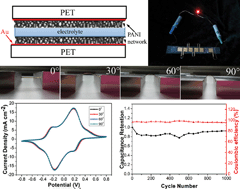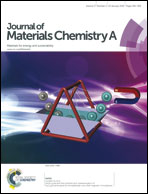Flexible and all-solid-state supercapacitors with long-time stability constructed on PET/Au/polyaniline hybrid electrodes
Abstract
In this work, symmetrical, flexible, and all-solid-state supercapacitors based on Au/polyaniline hybrid electrodes that are integrated on flexible polyethylene terephthalate substrates have been fabricated. The as-obtained supercapacitors have a maximum areal capacitance of 51.7 mF cm−2 at a current density of 0.1 mA cm−2 and a maximum energy density of 5.57 mW h cm−3 at the power density of 0.33 W cm−3, both of which are comparable to the values obtained for other currently available flexible and all-solid-state supercapacitors. In addition, the supercapacitors have excellent flexibility when they are bent to 90° with the CV curve remaining almost unchanged, and they possess superior cycling stability with the capacitance retention of 92.3% after 1000 cycles. Moreover, the supercapacitors have good corrosion resistance and long-time stability, of which the capacitive performance has almost no change after being left in an air atmosphere for two months or dipping in acidic or alkali solutions for 24 h. With these superior features, the supercapacitors hold great promise to be used in portable/wearable electronics.


 Please wait while we load your content...
Please wait while we load your content...